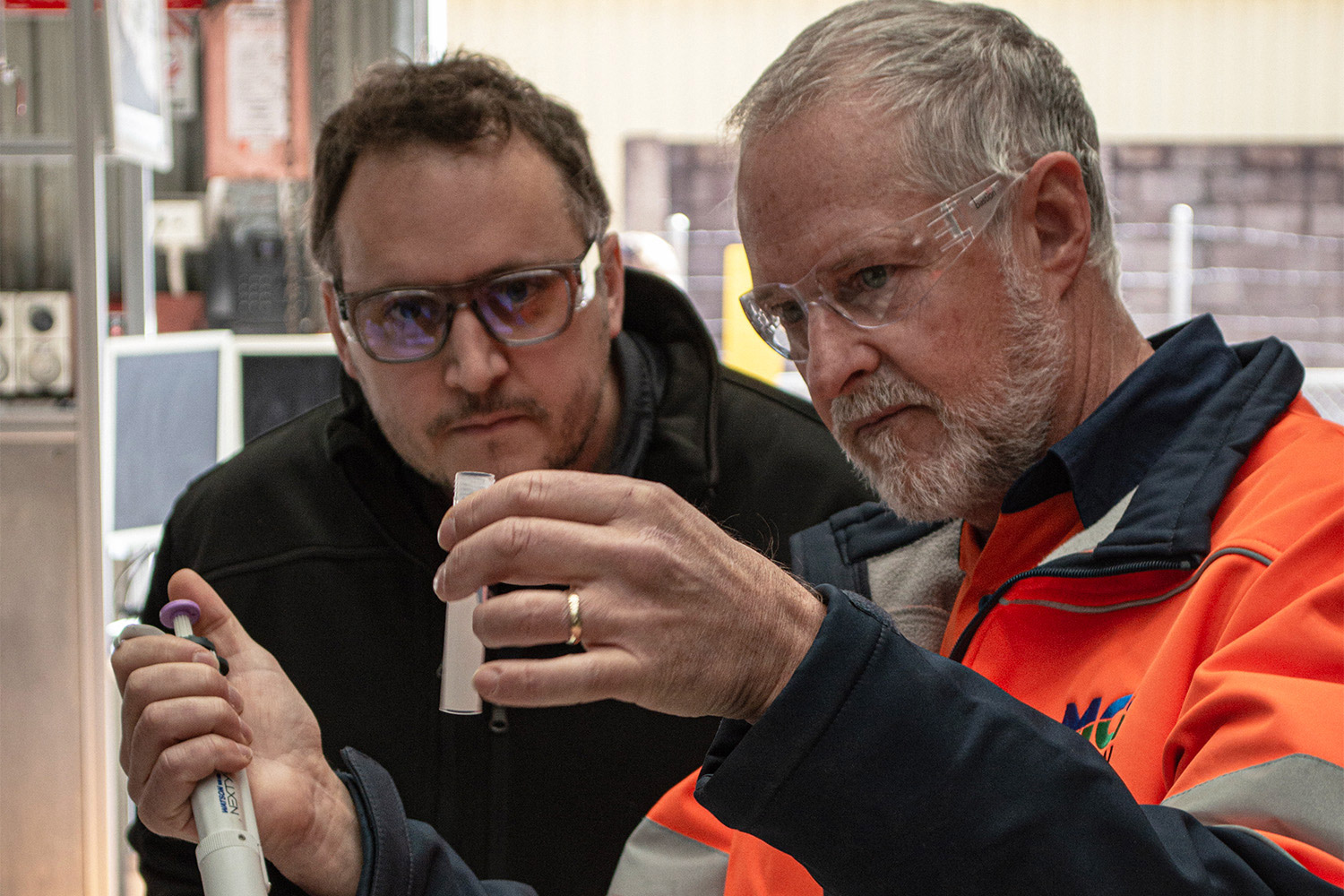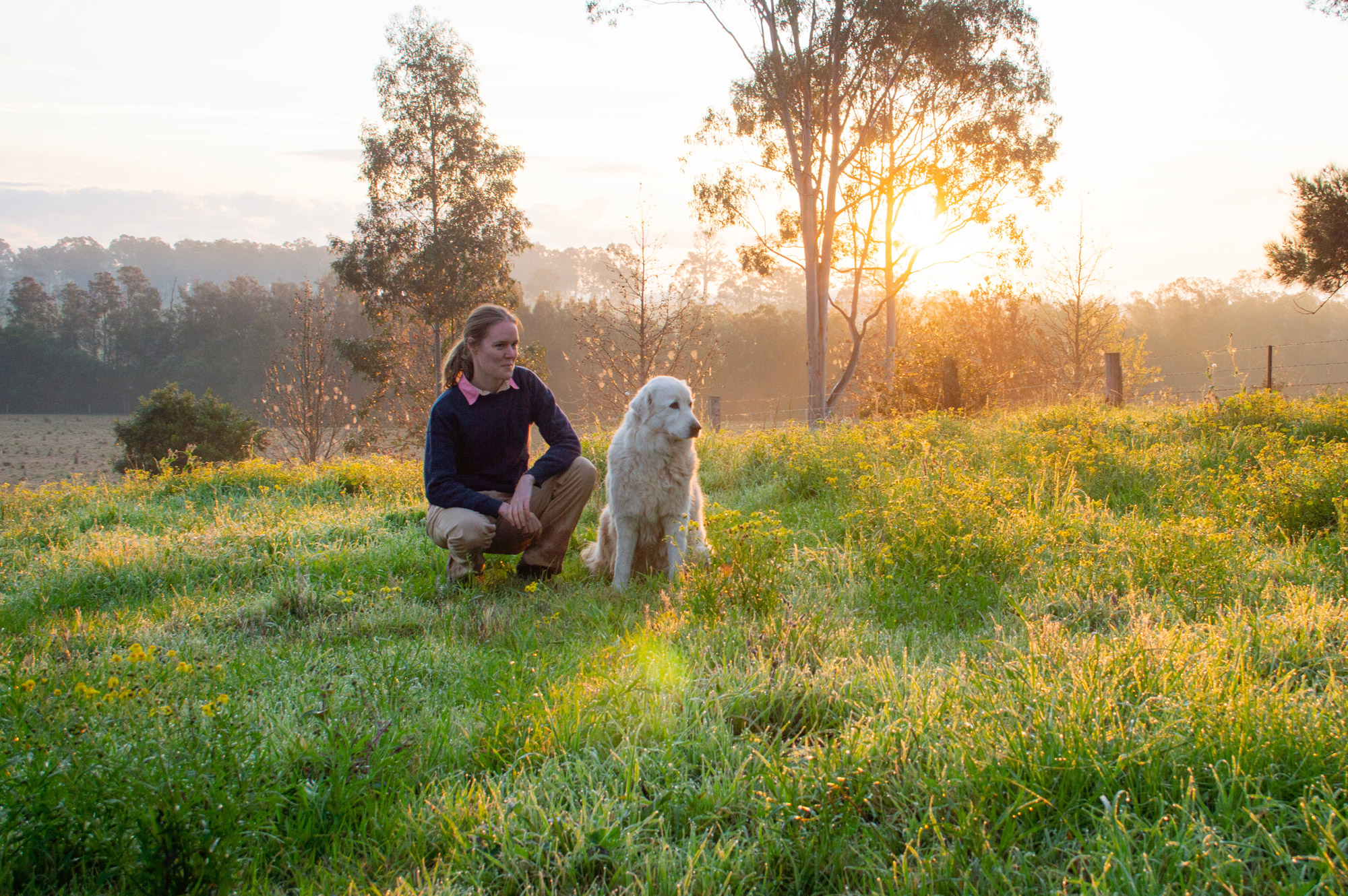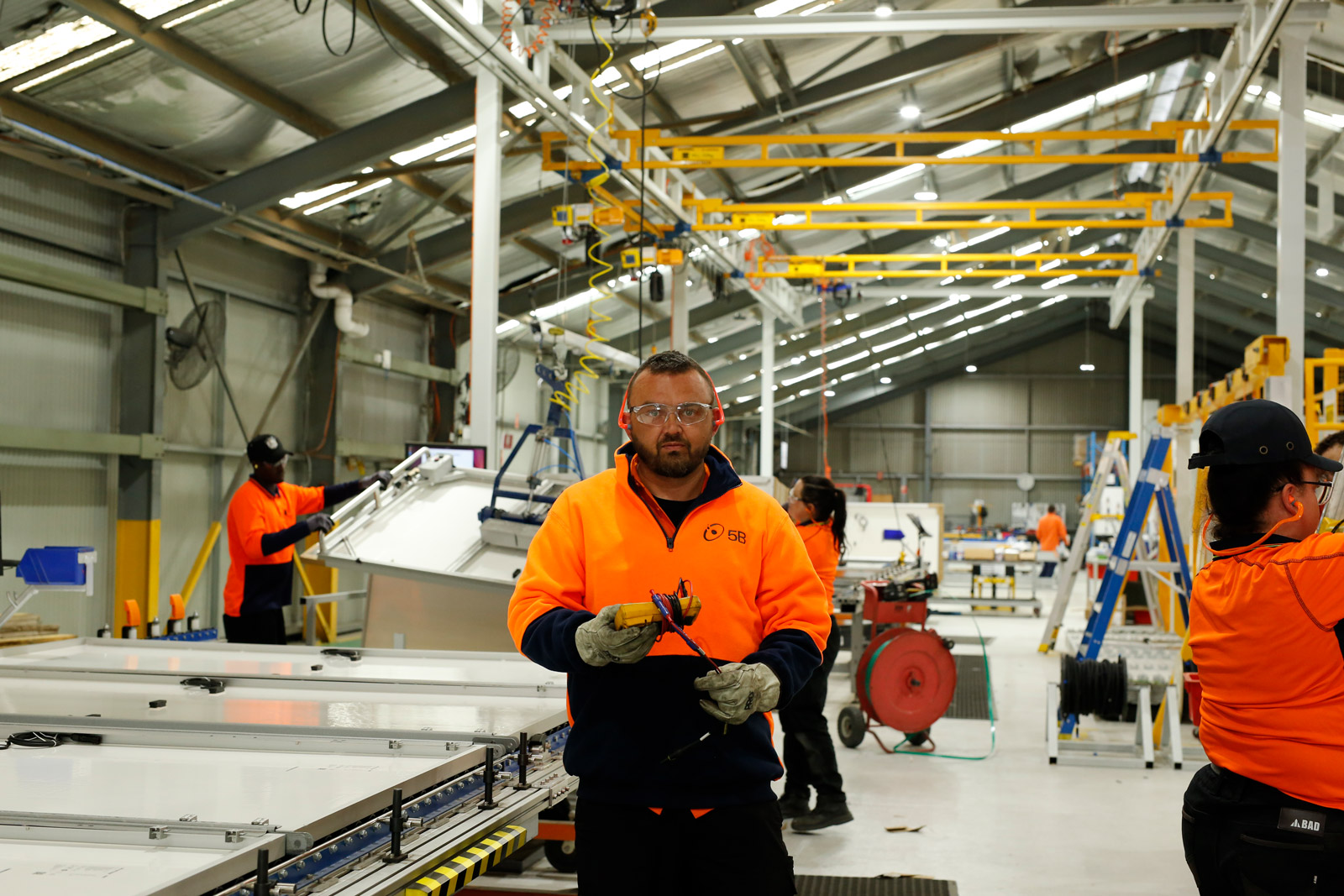Aim high and reap the rewards
Pay Off #1: More Australian jobs
A generational opportunity
Australia has already seen 32,180 jobs created from the renewables rollout, and 115,100 in our critical minerals industry.
As our clean energy industries grow, workers will get access to thousands of career opportunities in communities where jobs are needed most. This will have a flow-on effect in local regions, resulting in more opportunities for generations to come.
Snapshot
- 213,000 clean energy jobs by 2033
- 262,600 critical minerals jobs by 2040 to support production and processing of minerals like cobalt, lithium, manganese and rare earths
- 129,000 ongoing renewables jobs by 2050 for operations and maintenance of solar farms, wind farms, hydrogen plants and energy storage facilities
- Thousands of new jobs in regional clean energy hubs, including 34,000 jobs already slated for the Hunter community in NSW
Pay Off #2: A future-proof economy
Making building sustainable
Trent was never an advocate for climate action, but in December of 2019, the threat really hit home. After fire destroyed the family farm, he saw the need to adapt.
Five years on, the farm has a renewed focus on critical minerals, and Trent has left his old job in heavy industry for a role at MCi Carbon – a Newcastle-based clean tech start-up.
Now, he helps capture carbon dioxide and turn it into building materials, making heavy industry and buildings more sustainable at home and abroad.

Protecting our future, now
Locally made clean energy can power Australia and be sold to the world.
Our economy will be more than $300 billion dollars better off if we capitalise on our superior resources in solar, wind and mining, and the smarts of our home-grown clean energy businesses.
As the cheapest form of new power generation in history, renewables will continue to keep energy prices lower for households and businesses alike.
Snapshot
- Renewable energy from solar and wind is now the cheapest form of power
- Clean energy investment to increase by 300% by 2030
- Green industry exports – locally-made clean energy products, sold to the world – could be worth $333 billion by 2050
- Green metals development alone can add $40 billion to national income and $65 billion to Australian economic activity by 2050
Pay Off #3: More money in Aussie pockets
Harnessing our potential
Rolling out clean energy in Australia and around the world is the fastest way of reducing the worst impacts of climate change, including extreme weather events which are already causing costly disruptions – and devastation – to our farmers, businesses and local communities.
More money spent on disaster recovery means less money to spend on communities, schools, healthcare and housing.
Snapshot
- Australia could save $21 billion in disaster recovery costs per year by the world rapidly reducing the greenhouse gas pollution that causes climate change – that’s seven new hospitals a year
- Over 200,000 individual homes in NSW and 150,000 properties in QLD are at high risk of being uninsurable by 2030
- Insurance costs for extreme weather may increase an additional 70% by 2050
- Every $1 invested in climate adaptation and resilience can save up to $11 in recovery costs
Holding on to the family farm
Sophie’s farm has been in the family for five generations, but it could be under threat without planning for a sustainable future.
With major flooding hitting her region in recent years, she’s seen the impacts of extreme weather first-hand – and knows that more needs to be done to reduce the risk.
By installing batteries and solar, and increasing the farm’s water storage capacity, Sophie’s already reduced her power bills by 70%, future-proofing the farm in the process.

The path to the pay off
We can future-proof Australia by investing in clean energy.

-
We can future-proof Australia by investing in clean energy.
The cost of climate change and extreme weather events is continuing to climb, hitting farmers, small businesses and local communities the hardest. Acting on climate change is also Australia’s biggest financial opportunity – with potential to boost our economy by more than $300 billion dollars. Growing Australia’s clean industries will secure more jobs, financial stability, and cost savings for those who need it most.

-
To seize the opportunity, we need a strong target and a smart plan.
Early next year, the Government will set a new 2035 climate target to reduce its emissions as part of a global commitment to achieve Net Zero by 2050.
A strong target, along with a fair and smart plan for our renewables rollout, will ensure a pay off from the hard work already done by local Australian businesses to grow our clean energy industry.

-
Investment will grow our clean industries and local jobs.
A strong 2035 target – and a clear plan for the renewables rollout – will pave the path for investors to fund local clean energy businesses.
More financial backing for Australian innovations and manufacturing will create thousands of jobs in local communities and strengthen our entire economy.
That’s the path to the pay off.
Clean energy jobs: The data
Climate action is Australia’s biggest economic opportunity. Access the research to find out more.
Frequently Asked Questions
1. Are there really thousands of jobs in clean energy?
Yes. There have already been 32,180 jobs created in Australia from the renewables rollout, 115,100 in our critical minerals industry, and the opportunities are growing.
To unlock the full potential of clean energy jobs, we need the government to set a strong climate target which sets out what Australia wants to achieve by 2035.
Investment in clean energy is ready to increase 300% by 2030. With a strong plan, Australia can seize this opportunity to grow its local clean energy industries, delivering thousands more jobs.
2. How can Australian manufacturing and clean energy businesses succeed against overseas competition?
Home-grown Australian businesses have already proven their smarts and capabilities as clean energy innovators. From inventing the solar panel, to developing recyclable batteries and sustainable building materials made of carbon dioxide, there are numerous Australians who are building great businesses focused on addressing the climate challenge.
To continue growing and reach their full potential, they will need stable and clear government policies which back Australian jobs, innovation and manufacturing. This will pave their path to secure the investment they need to scale up their operations.
3. What about nuclear? Why don’t we invest in that instead of renewables which don’t run all the time?
For Australia, the right solution is renewables like solar and wind, backed by batteries, hydro and a small amount of gas.
Renewables are proven as the cheapest energy sources, especially in Australia where we have abundant sunshine and wind. They will keep our energy system reliable, keep the lights on, and keep power bills and pollution low.
In contrast, nuclear is double the cost of renewables, can’t be built in time to replace the coal plants that will shut down, and its feasibility in Australia is uncertain. Every comparable project overseas has gone way over budget and taken much longer than expected – and those countries already had nuclear industries.
Compared with other countries, Australia has an abundance of solar, wind and critical minerals which we can harness into cheap, reliable, locally made clean energy.
4. My power bills have been going up since renewables came onto the grid. How will more of them result in cheaper bills?
Fossil fuels like coal and gas have been driving up power prices, while renewables have been keeping energy costs lower than they would have been otherwise.
Australia’s old coal plants are shutting down and gas is expensive, which puts more upward pressure on power prices.
Renewable energy generated from solar and wind is now the cheapest form of power, and continued investment in growing our renewable energy generation and storage will mean cheaper power bills.
5. What’s the Paris Agreement, and Net Zero by 2050?
The Paris Agreement is the way that almost all the world’s countries, including Australia, are working together to prevent the worst impacts of climate change.
Net Zero by 2050 is the goal: by getting greenhouse gas emissions as close to zero as possible, and removing any remaining emissions from the atmosphere, we can limit the damage and disruption of climate change.
As part of the Paris Agreement 195 countries across the world, including Australia, have pledged to achieve Net Zero by 2050 (all the countries in the world except 3).
The Paris Agreement works on a five-year cycle of increasingly ambitious climate action.
Every five years, each pledged country submits an updated national climate target and action plan for how they are reducing greenhouse gas emissions and building resilience to rising global temperatures.
6. What’s the effect of climate targets on cost of living and bills?
Climate targets help with cost of living pressures, because they help give businesses and investors the confidence to supply cheaper energy:
Renewable energy, like solar and wind backed up by batteries and pumped hydro, is now the cheapest and cleanest form of energy.
As aging coal power stations reach retirement and exit the system over the next decade, we need to invest in the cheapest and cleanest alternatives to secure cheaper power bills and reduce cost-of-living.
By investing in renewable energy we are also reducing the chance of costly and damaging extreme weather events by helping limit the effects of climate change.
7. Are we on track to meet the current climate targets? Why would we aim for higher targets?
The most recent projections show Australia is within close distance of its current climate target for 2030 (43%), by one percentage point (42%).
Every target is critical to investment and growth; targets provide the policy certainty and direction investors and local businesses need to fund and grow clean energy industries and local jobs.
Without strong targets and a smart plan for the renewables rollout in Australia, investors will be forced to consider more certain investment opportunities overseas.
Without increased investment, our targets will be harder to reach, and local businesses are more likely to miss out on critical funding they need to scale their operations and create more jobs.
8. How much has the renewables rollout cost Australia?
The Australian Energy Market Operator (AEMO) has confirmed it will take $122 billion over the next two decades to reach net zero. By comparison the Australian superannuation system currently manages $3.9 trillion, and $133 billion came into the system in the last twelve months. So that level of investment is achievable.
Continuing to roll out renewables is the cheapest option available to Australia in terms of the investment needed to power our energy systems into the future. It will deliver cheaper power bills for families and businesses.
With the right policy settings, our economy stands to gain more than $300 billion by capitalising on our superior resources in solar, wind and mining to grow our clean energy workforce.
9. Who is behind this website?
We are the Investor Group on Climate Change (IGCC), an industry group created by Australia’s top superfunds and investors who take care of the retirement savings of 14.8 million Australian workers.
Our goal is to protect Australia’s super and investments from the damaging costs of climate change and to make sure Australians financially benefit from the transition to a clean economy.

